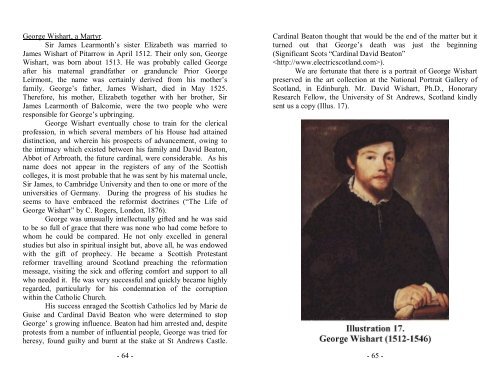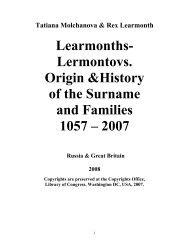LEARMONTH-LERMONTOV. A HYISTORY OF THE NAME AND FAMILIES
By Tatiana Molchanova and Rex Learmonth, 2011
By Tatiana Molchanova and Rex Learmonth, 2011
- No tags were found...
Create successful ePaper yourself
Turn your PDF publications into a flip-book with our unique Google optimized e-Paper software.
George Wishart, a Martyr.<br />
Sir James Learmonth’s sister Elizabeth was married to<br />
James Wishart of Pitarrow in April 1512. Their only son, George<br />
Wishart, was born about 1513. He was probably called George<br />
after his maternal grandfather or granduncle Prior George<br />
Leirmont, the name was certainly derived from his mother’s<br />
family. George’s father, James Wishart, died in May 1525.<br />
Therefore, his mother, Elizabeth together with her brother, Sir<br />
James Learmonth of Balcomie, were the two people who were<br />
responsible for George’s upbringing.<br />
George Wishart eventually chose to train for the clerical<br />
profession, in which several members of his House had attained<br />
distinction, and wherein his prospects of advancement, owing to<br />
the intimacy which existed between his family and David Beaton,<br />
Abbot of Arbroath, the future cardinal, were considerable. As his<br />
name does not appear in the registers of any of the Scottish<br />
colleges, it is most probable that he was sent by his maternal uncle,<br />
Sir James, to Cambridge University and then to one or more of the<br />
universities of Germany. During the progress of his studies he<br />
seems to have embraced the reformist doctrines (“The Life of<br />
George Wishart” by C. Rogers, London, 1876).<br />
George was unusually intellectually gifted and he was said<br />
to be so full of grace that there was none who had come before to<br />
whom he could be compared. He not only excelled in general<br />
studies but also in spiritual insight but, above all, he was endowed<br />
with the gift of prophecy. He became a Scottish Protestant<br />
reformer travelling around Scotland preaching the reformation<br />
message, visiting the sick and offering comfort and support to all<br />
who needed it. He was very successful and quickly became highly<br />
regarded, particularly for his condemnation of the corruption<br />
within the Catholic Church.<br />
His success enraged the Scottish Catholics led by Marie de<br />
Guise and Cardinal David Beaton who were determined to stop<br />
George’ s growing influence. Beaton had him arrested and, despite<br />
protests from a number of influential people, George was tried for<br />
heresy, found guilty and burnt at the stake at St Andrews Castle.<br />
- 64 -<br />
Cardinal Beaton thought that would be the end of the matter but it<br />
turned out that George’s death was just the beginning<br />
(Significant Scots “Cardinal David Beaton”<br />
).<br />
We are fortunate that there is a portrait of George Wishart<br />
preserved in the art collection at the National Portrait Gallery of<br />
Scotland, in Edinburgh. Mr. David Wishart, Ph.D., Honorary<br />
Research Fellow, the University of St Andrews, Scotland kindly<br />
sent us a copy (Illus. 17).<br />
- 65 -






